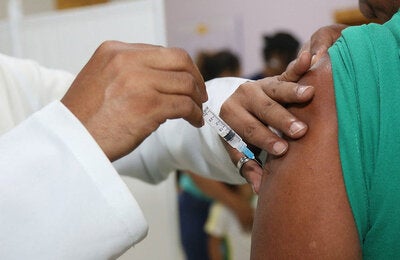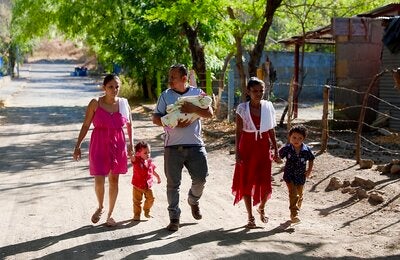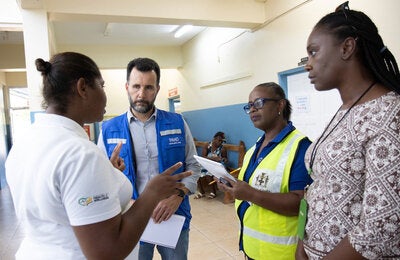
PAHO/WHO calls for action to curb dangerous growth of antimicrobial resistance
Washington, D.C., 7 April 2011 (PAHO/WHO) — The widespread misuse of antimicrobial medications, coupled with poor patient care in health facilities, could lead to a future of deadly "untreatable infections," experts said today in panel discussions organized by the Pan American Health Organization/World Health Organization (PAHO/WHO) for World Health Day 2011.
"With the help of antimicrobials, we have made important advances in public health in the Americas region," said PAHO Director Dr. Mirta Roses, at a World Health Day event in Montevideo, Uruguay. "These include declines in tuberculosis, malaria, deaths from HIV/AIDS, congenital syphilis, and child and maternal deaths due to infectious causes. Nevertheless, all these advances are seriously threatened by the constant increase in the number of pathogens that are resistant to antimicrobials."
"Antibiotics are a true success story," said Dr. Anthony Fauci, Director of the U.S. National Institute of Allergy and Infectious Diseases, at PAHO/WHO headquarters in Washington, D.C. "But microbes develop ways to circumvent them. The examples are many. Antimicrobial resistance has become a key stumbling block in our efforts to control many important infectious diseases in global health."
Drug resistance is a natural biological process by which microbes acquire the ability to resist drugs designed to kill them. Resistant genes are passed on to new generations of microbes, becoming more dominant until the resisted drug becomes ineffective.
Chief contributors to the process include doctors who incorrectly prescribe antibiotics, people who purchase the drugs without a prescription, and patients who do not take all their drugs as prescribed. Also key are poor infection control practices in hospitals and health facilities, and the widespread use of antibiotics in the production of food animals.
In combination, these factors are producing growing resistance among microbes that threatens to outpace the development of new, more effective drugs.
Indeed, the introduction of new antimicrobial drugs has declined significantly since the 1980s and 1990s, noted Dr. Marcelo Galas, of Argentina's Ministry of Health. "If we continue like this, in short time we will be left with nothing."
Dr. Susan Foster, of the Alliance for the Prudent Use of Antibiotics, estimated that antimicrobial resistance costs as much as $34 billion per year in the United States alone, similar to what is spent on diabetes. This is due to longer hospital stays, more expensive medications, and increased need for screening and diagnostics. Other, indirect costs include poor patient health, long-term disability, increased deaths, and economic impacts on individuals and families.
"And behind these statistics, we have to remember there are real people whose lives have been dramatically affected," said Foster.
Claudia Palacios, weekend news anchor for CNN Spanish, recalled the tragic effect of antimicrobial resistance on a young couple she knew in her native Colombia. Following routine surgery, the young father succumbed to a hospital-acquired "superbug," leaving behind his wife and their 4-month-old baby.
"Whenever I do a report on the use of medications, I remember that truncated family and I try to make viewers think about the serious consequences of an act as simple as taking an antibiotic," said Palacios. "It may seem like the fastest solution for an ailment, but a badly used medication is really an attempt on one's life and on the lives of others."
In the Americas region, major problems with antimicrobial resistance now include:
- Multiresistant hospital-acquired infections, which in some countries claim more lives annually than HIV/AIDS, influenza, and traffic accidents combined.
- Community-acquired infections, especially urinary and respiratory infections, that no longer respond to routine antibiotics but require more expensive, wide-spectrum drugs.
- Multidrug-resistant tuberculosis (MDR-TB), which now affects all the countries of the Americas, and extensively drug-resistant TB (XDR-TB), which has been reported in most of the region's countries and for which there is no effective treatment.
- Growing resistance to ampicillin and trimethoprim/sulfamethoxazole, which were but are no longer effective against dysentery.
- Resistance to chloroquine developed by the malaria parasite P. falciparum, thus requiring the use of more expensive treatments.
- Some 15 percent of people with HIV who receive antiretroviral treatment (ART) in the Americas now require second- and third-line drugs, which are as much as 100 times more expensive than first-line drugs. This additional cost threatens the region's goal of providing universal access to ART.
To address these problems, PAHO/WHO has been working with countries throughout the Americas to improve drug regulatory systems, strengthen surveillance and laboratory capacity, ensure access to good-quality essential medicines, improve infection prevention and control, and promote research and development.
A key component of this work is the promotion of patient safety through such PAHO/WHO initiatives as "Clean Care is Safer Care" and the "Safe Surgery Checklist" for surgical personnel.
"More than 50 percent of hospital-acquired infections are preventable," said Dr. Orlando Urroz, of the Costa Rican Social Security Fund. "We need to teach patients and healthcare workers simple, cost-effective measures to prevent infection and improve the quality of care."
To monitor the emergence of antimicrobial resistance, PAHO/WHO supports the Latin American Network for Monitoring Antimicrobial Resistance (RELAVRA), established in 1996. The network now covers 21 countries from Canada to Chile and includes 21 reference labs and 521 sentinel sites that collect information on drug resistance throughout the hemisphere.
As part of this year's World Health Day Campaign, whose theme is "No action today, no cure tomorrow," PAHO and WHO today called on all countries to adopt a six-point policy package to combat antimicrobial resistance.
"Antimicrobial resistance is not a phenomenon on the horizon; it is here today," said PAHO Deputy Director Dr. Jon Andrus. "Let us remember that only by working together can we combat antimicrobial resistance. And let us heed the warning that if we don't take action today, we will have no cure tomorrow. None of us wants that to happen."
The Pan American Health Organization, founded in 1902, works with all the countries of the Americas to improve the health and quality of life of their peoples. It serves as the Regional Office of the World Health Organization (WHO).



